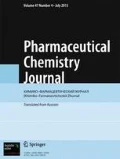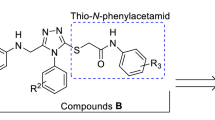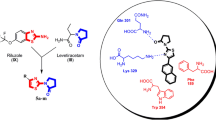In the search for new anticonvulsants, the (arylalkyl)azole framework has been considered as a valuable scaffold. Accordingly, a series of trans-3-imidazolylflavanones (1 – 15) and their flexible analogs 1-[(2-benzyloxy)phenyl]-2-(azol-1-yl)ethanones (16 – 19) containing an (arylalkyl)azole substructure were evaluated for their anticonvulsant activities by using pentylenetetrazole (PTZ) and maximal electroshock (MES)induced seizure tests. Also, the effect of substituent on the pendant phenyl ring and the impact of structural flexibility were investigated. The obtained results revealed that 2-(azol-1-yl)ethanone derivatives 16 – 18 exhibited 50 – 100% protection against MES-induced seizures at a dose of 100 mg/kg. Particularly, compound 16 was found to be significantly active at doses of 10 and 30 mg/kg (25 and 75% protection, respectively). This compound showed full protection at a dose of 100 mg/kg. The structure – activity relationship study revealed that the dichloro substituent in the secondary phenyl ring can improve the anticonvulsant activity. Furthermore, disconnection of the C2 – C3 bond of flavanone in trans-3-imidazolylflavanones results in flexible analogs 1-[(2-benzyloxy)phenyl]-2-(azol-1-yl)ethanones with improved anticonvulsant activity. Docking study of representative compound 16 with possible targets involved in convulsions demonstrated that the GABAA receptors can be considered as the main target for anticonvulsant activity of compound 16.



Similar content being viewed by others
References
O. T. Jones, Eur. J. Pharmacol., 447, 211 – 225 (2002).
S. Dalkara and A. Karakurt, Curr. Top. Med. Chem., 12, 1033 – 1071 (2012).
T. R. Brown and G. L. Holmes, New Engl. J. Med., 344, 1145 – 1151 (2001).
E. Perucca, Ther. Drug Monit., 24, 74 – 80 (2002).
J. S. Duncan, Br. J. Clin. Pharmacol., 53, 123 – 131 (2002).
J. O. McNamara, The Goodman and Gilman’s Pharmacological Basis of Therapeutics, 10th ed., J. G. Hardman and L. E. Limbird (Eds.), McGraw-Hill (2001), pp. 521 – 547.
R. J. Porter and B. S. Meldrum, Basic Clinical Pharmacology, 8th ed., B. G. Katzung (Ed.), McGraw Hill, 2001, pp. 395 – 418.
S. I. Johannessen and C. J. Landmark, Curr. Neuropharmacol., 8, 254 – 267 (2010).
M. M. Goldenberg, Pharm. Therapeutics, 35, 392 – 415 (2010).
B. Malawska, Curr. Top. Med. Chem., 5, 69 – 85 (2005).
K. A. Walker, M. B. Wallach, and D. R. Hirschfeld, J. Med. Chem., 24, 67 – 74 (1981).
D. Nardi, A. Tajana, and A. Leonardi, et al., J. Med. Chem., 24, 727 – 731 (1981).
A. Ayati, S. Emami, and A. Foroumadi, Eur. J. Med. Chem., 109, 380 – 392 (2016).
S. Emami, A. Kebriaeezadeh, M. J. Zamani, and A. Shafiee, Bioorg. Med. Chem. Lett., 16, 1803 – 1806 (2006).
A. Kebriaeezadeh, S. Emami M. Ebrahimi, et al., Biomed. Pharmacother., 62, 208 – 211 (2008).
S. Emami, M. Behdad and A. Foroumadi, et al., Chem. Biol. Drug Des., 73, 388 – 395 (2009).
S. Emami, M. Kazemi-Najafabadi and S. Pashangzadeh, et al., Chem. Biol. Drug Des., 78, 979 – 987 (2011).
A. K. Chaturvedi, J. P. Barthwal, S. S. Parmar and V. I. Stenberg, J. Pharm. Sci., 64, 454 – 456 (1975).
R. L. Krall, J. K. Penry, B. G. White, et al., Epilepsia, 19, 409 – 428 (1978).
L. Richter, Nat. Chem. Biol., 8, 455 – 464 (2012).
G. M. Lipkind and H. A. Fozzard, Mol. Pharmacol., 78, 631 – 638 (2010).
H. Irannejad, H. Nadri, N. Naderi, et al., Med. Chem. Res., 24, 2505 – 2513 (2015).
W. Löscher, Epilepsy Res., 50, 105 – 123 (2002).
Acknowledgments
This work was supported by grant from the Research Council of Mazandaran University of Medical Sciences, Sari, Iran. A part of this work was related to the Pharm. D. Thesis of Samira Hafezi (Faculty of Pharmacy, Mazandaran University of Medical Sciences).
Author information
Authors and Affiliations
Corresponding author
Rights and permissions
About this article
Cite this article
Ahangar, N., Hafezi, S., Irannejad, H. et al. Anticonvulsant Activity of 3-imidazolylflavanones and Their Flexible Analogs: 1-[(2-benzyloxy)phenyl]-2-(azol-1-yl)ethanones as New Lead Compounds. Pharm Chem J 51, 787–792 (2017). https://doi.org/10.1007/s11094-017-1694-0
Received:
Published:
Issue Date:
DOI: https://doi.org/10.1007/s11094-017-1694-0




